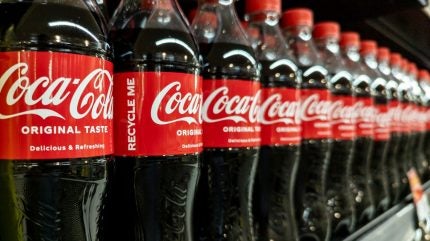
Europe’s two major Coke bottlers saw their share prices sour yesterday (6 August) but the market reaction was overplayed.
Coca-Cola HBC’s half-year figures were in positive territory across the board. The group booked 9.9% organic and 8.6% reported growth in net sales revenue, which reached €5.6bn. Total volumes grew 2.6% in both organic and reported terms, to 1.46bn unit cases.
Reported operating profit was also up 13.9% at €644.6m, while net profit grew 23.3% on 2024 to €474.7m.
Meanwhile, CCEP’s total first-half and second quarter figures were also in the green. Revenue was up 4.5% on a reported and comparable basis to €10.3bn. Reported operating profit grew 19.4$ and 7.3% in comparable terms, to €1.4bn. Comparable profit after taxes increased 2.9% and 15.5% on a reported basis, at €937m.
Reported and comparable group volumes increased 4.1% and 5.5% to 1.9bn unit cases.
However, in Europe, CCEP’s volumes did decline slightly in the period by 0.3% in comparable terms and 1.9% on a reported basis to 1.2bn unit cases.

US Tariffs are shifting - will you react or anticipate?
Don’t let policy changes catch you off guard. Stay proactive with real-time data and expert analysis.
By GlobalDataVolumes in South East Asia were also relatively flat a softer consumer environment caused a decline in Indonesia.
Much investor disappointment over the past 24 hours has focused on the changes of guidance made by Coca Cola HBC and CCEP for the rest of their financial years.
Coca-Cola HBC reiterated its guidance for 2025 but now expects to hit the “top-end” of its guided ranges for organic revenue growth of 6% to 8%, and organic EBIT growth of 7% to 11%. In early trading in London yesterday, the company’s share price fell by around 9%.
The group’s narrowing to the top-end of the guidance range isn’t really bad news, but, as Bernstein’s Nadine Sarwat put in a note to clients, today: “The market (and also sell-side per consensus) was expecting a raise.” Investors had anticipated better.
Coca Cola HBC’s comparable operating profit was also “incredibly uneven”, she noted, as its emerging markets were the only part of the business to see a significant boost in operating profit at 31%. The company’s Established and Developing markets division both dipped in organic EBIT, by 7.2% and 0.6%.
At CCEP, the company had previously forecast a 4% increase in revenue for 2025 but tweaked that slightly to an increase of “3% to 4%”. Its shares fell by as much as 12% in London yesterday.
Barclays analyst Lauren Lieberman said the market response was also “driven by a European volume recovery that came in shy of expectations, which admittedly seemed to creep up over the summer”.
Market reaction, however, has not deterred analysts’ confidence in either company.
According to Sarwat, the market response to Coca-Cola HBC was “overdone”. She added: “The market this consumer season has been volatile (to say the least), and in many cases unforgiving on relatively small disappointments.”
Sarwat, meanwhile, said CCEP had faced “high expectations” ahead of the release of its results, amid the “backdrop” of the group being protected from major threats other drinks companies are facing, like US tariffs or vulnerability “to the uncertain US or China consumer”.
Delving deeper into CCEP’s second quarter equally doesn’t show much reason to panic. In the three-month period, despite seeing a low single-digit dip in sales in South East Asia, linked to Indonesia, the group still saw total reported revenue grow 4.1%. As Sarwat noted: “The Q2 print itself was solid.”
Bernstein still expects CCEP to achieve its growth targets but Sarwat did add the bank did not expect the bottler to achieve revenue growth of beyond 4% this year.
Reflecting on CCEP’s performance, Lieberman said the results wouldn’t do much to “yield a drastic change” in Barclays’ expectations for the group’s profit or free cash flow in 2025.
She added: “We remain comfortable with the outlook (inclusive of an acceleration in European volumes from here) and continue to like CCEP for its attractive fundamental story in 2025+ and view it as a compelling core holding within broader staples.”
Overall, both CCEP and Coca-Cola HBC remain solid performers and, perhaps, the companies’ recent strong showings had led some investors to set their expectations for the rest of the year too high.





